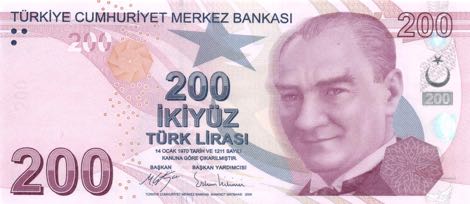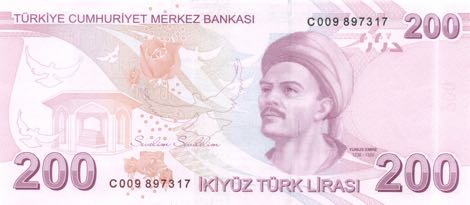Turkey
Turkey replaces central bank governor Çetinkaya
06 07, 2019 09:40 Category: Europe
According to an article in The Guardian dated 3 July 2019, Turkey has fired Murat Çetinkaya, governor of the Central Bank of Turkey from April 2016, replacing him with deputy Murat Uysal.
Courtesy of Dennis Zammit.
Courtesy of Dennis Zammit.
Turkey new signature 20-lira note (B302c) confirmed
15 05, 2019 08:12 Category: Europe

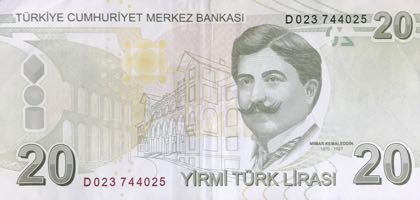
Like B302b, but new signatures (Murat Çetinkaya and Uğur Namık Küçük). Prefix D023. Intro: 24.12.2018.
Courtesy of Paul Nahmias.
30% off select chapters of The Banknote Book in print
02 12, 2019 06:43 Category: The Banknote Book
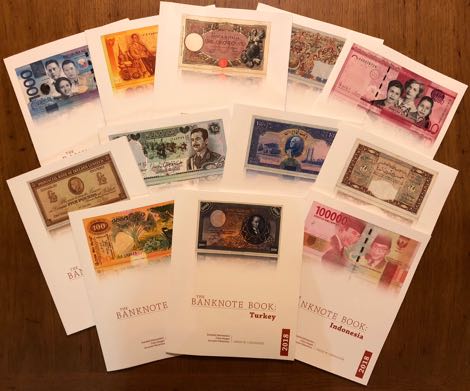
In response to customer demand, 26 of the largest chapters of The Banknote Book are now available in print.
The following chapters can now be ordered in print directly from Lulu.com or Amazon
Algeria
Argentina
Australia
Belgium
Bolivia
Bulgaria
Ceylon
Cuba
Dominican Republic
Egypt
Fiji
Germany
Indonesia
Iran
Iraq
Italy
Japan
Lebanon
Macau
Northern Ireland
Philippines
Romania
Syria
Thailand
Turkey
Venezuela
Prices range from US$24.99 to US$39.99, depending upon length, and all are professionally printed in full color on 80-pound glossy paper as perfect-bound paperback books.
Anyone purchasing from Lulu.com is entitled to a coupon code good for a free download of the PDF version of the chapter (US$9.99 value).
Use coupon code CYBERMONDAY30 when ordering on Lulu to get 15% off the list price for orders placed before midnight 3 December 2019.
Check Lulu's home page for discount codes on books and shipping.
Turkey new signature 200-lira note (B305c) confirmed
14 11, 2017 09:26 Category: Europe
Turkey new signature 50- and 100-lira notes (B303c and B304c) reported
19 07, 2017 10:33 Category: Europe
According to a press release dated 14 July 2017, the Central Bank of the Republic of Turkey has introduced new signature varieties for its 50- and 100-lira notes (B303c and B304c, respectively).

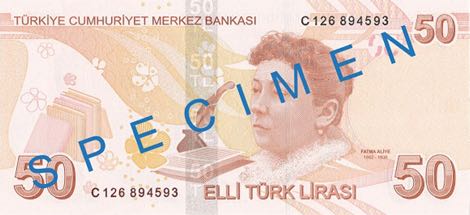
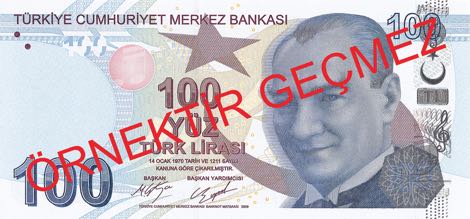

Courtesy of Nazim Alper Ates and M. Okyay Demirors.




Courtesy of Nazim Alper Ates and M. Okyay Demirors.
Turkey new signature 5-lira note (B306b) confirmed
09 05, 2017 10:08 Category: Europe
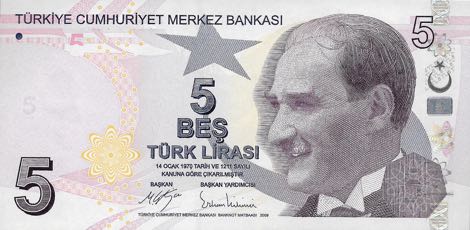
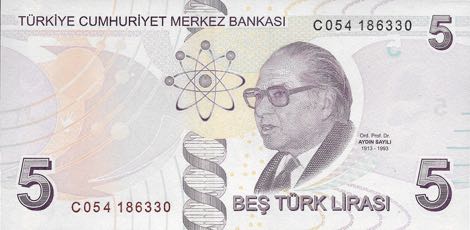
Like B306a, but new signatures (Murat Çetinkaya and Erkan Kilimci). Prefix C054.
Courtesy of Paul Nahmias.
Turkey new signature 10-lira note (B301c) confirmed
09 05, 2017 10:06 Category: Europe
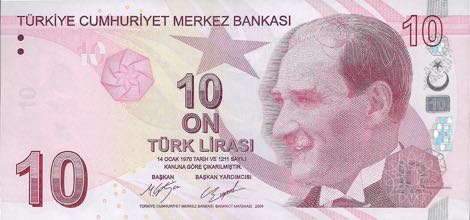
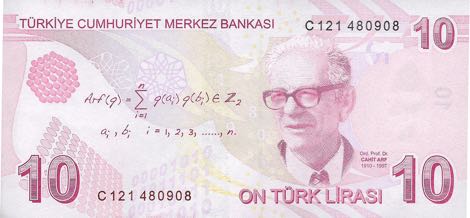
Like B301b, but new signatures (Murat Çetinkaya and Murat Uysal). Prefix C121.
Courtesy of Paul Nahmias.
Turkey new signature 5-, 10-, and 200-lira notes reportedly introduced 27.03.2017
According to a press release dated 25 March 2017, the Central Bank of the Republic of Turkey plans to introduce 5-, 10-, and 200-lira notes (B300, B301, B305, respectively) with new signatures on 27 March 2017.
Courtesy of M. Okyay Demirors.
Courtesy of M. Okyay Demirors.
Press release: The Banknote Register 2nd edition
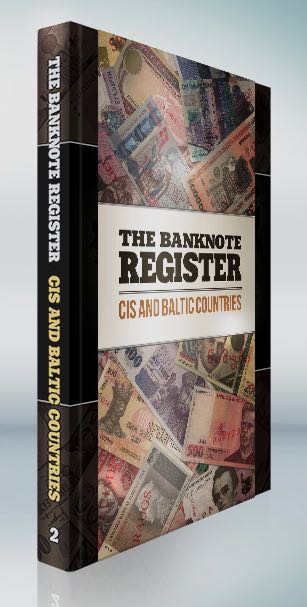
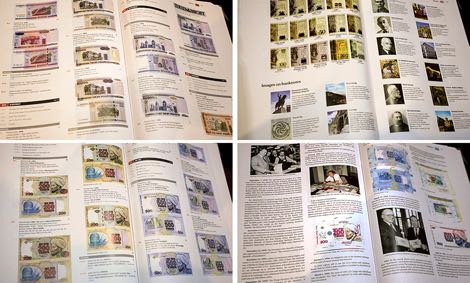
The Banknote Register: CIS and Baltic Countries
1991-2016, General Issues
Second edition (English)
Author: Dmitry Zagorenko (IBNS #11608, General Secretary of the Russian Chapter of IBNS).
Editor: Dmitry Litvak (IBNS LM #204, President of the Russian Chapter of IBNS).
Format: A4. Weight: 1,5 Kg.
Hard cover with pressed gilding and book jacket band.
344 full-color pages (paper 115 g/m2).
16 Chapters (Russia, Ukraine, Belarus, Uzbekistan, Kazakhstan, Georgia, Azerbaijan, Lithuania, Moldova, Transnistria, Latvia, Kyrgyzstan, Tajikistan, Armenia, Turkmenistan, Estonia).
Edition: 1000 pieces.
The Banknote Register provides the most detailed information on all emissions of paper money in post-Soviet countries from 1991 to present. It describes the history of money circulation establishment and development in the new sovereign states. The book gives detailed information on each banknote, variations and types, commemorative and souvenir issues, security features, designers, signatories, serial prefixes, images portrayed on the notes. It will be no exaggeration to say that the author with the help of collectors and staff of national banks has compiled the best known up to now data, many of which will be published for the first time, and also data unknown to many collectors. This work has resulted in compilation and classification of the most complete information on currency circulation in the post-Soviet countries.
The publication of the Register will, for sure, reduce the number of blank spaces in the history of circulation in CIS and Baltic states. Nevertheless, the author continues searching for materials and communicating with paper money collectors, museum workers, designers and bank specialists and laymen. We hope that the Register of Banknotes of CIS and Baltic Countries will encourage you as well to study actively the currency circulation in the post-Soviet countries.
Promo-video: https://youtu.be/O33FxdonxS0
Official website: http://banknote-register.com
For a $7 discount off the list price of $62, use the coupon code "BanknoteBook" when ordering the book by email. Registered shipment to any country in the world is $22, so the total discounted cost is only US$77.
Turkey chapter of The Banknote Book is now available
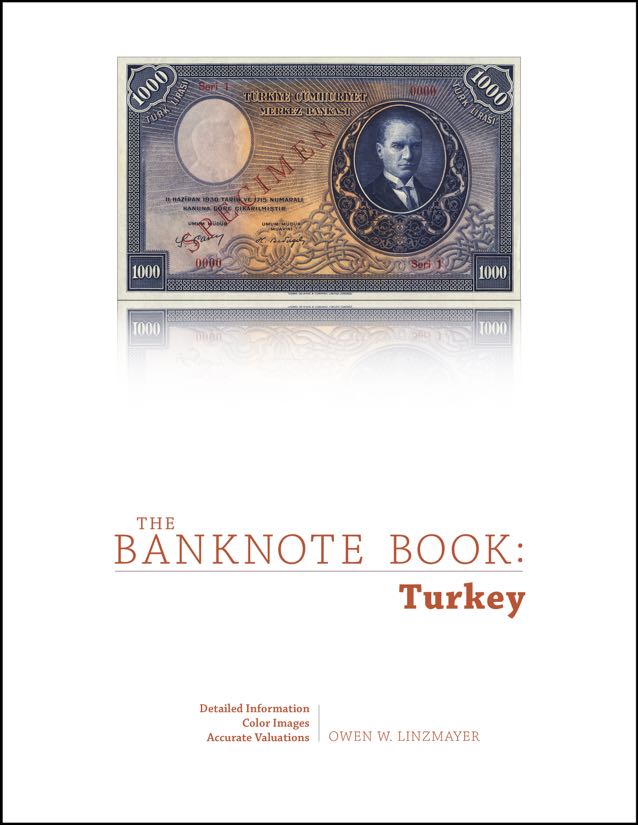
The Turkey chapter of The Banknote Book is now available for individual sale and as a free download to subscribers.
This 38-page catalog covers notes issued by the Ministry of Finance in 1926, and the Türkiye Cümhuriyet Merkez Bankası (Central Bank of Turkey) from 1930 to present. Revised 10 July 2016.
Each chapter of The Banknote Book includes detailed descriptions and background information, full-color images, and accurate valuations. The Banknote Book also features:
- Sharp color images of note’s front and back without overlap
- Face value or date of demonetization if no longer legal tender
- Specific identification of all vignette elements
- Security features described in full
- Printer imprint reproduced exactly as on note
- Each date/signature variety assigned an individual letter
- Variety checkboxes for tracking your collection and want list
- Date reproduced exactly as on note
- Precise date of introduction noted when known
- Replacement note information
- Signature tables, often with names and terms of service
- Background information for historical and cultural context
- Details magnified to distinguish between note varieties
- Bibliographic sources listed for further research
Subscribe to The Banknote Book
If you collect the entire world or a large number of countries, buying a subscription is the best deal because it's less expensive than buying chapters individually, and it entitles you to every chapter currently available as well as everything published—or revised (click here to see the Change Log)—during the term of your subscription.

Sign up for Email Notifications
If you would like to receive email notifications whenever a new chapter of The Banknote Book is published, please join the email list by clicking the button below.

Turkey new 5-lira note issued 08.04.2013 confirmed
25 04, 2013 08:48 Category: Europe | South Asia
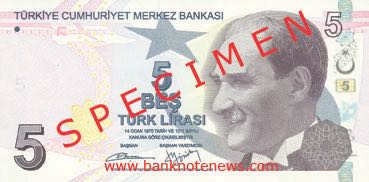
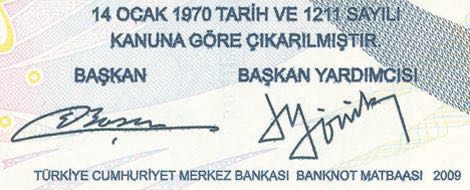
On 8 April 2013, Türkiye Cümhuriyet Merkez Bankası (Central Bank of Turkey) issued a new 5-lira note that is purple, because the exisiting tan note (P222) was too close in color to the brown 50-lira note (P225).
In addition to the new color of the 5-lira note, the bank also changed the Deputry Governor signatures on the following notes (all the new notes have Governor Erdem Başçı’s signature, seen above at left):
· TL 200 banknotes: Mehmet Yörükoğlu
· TL 50 banknotes: Turalay Kenç,
· TL 5 banknotes: Mehmet Yörükoğlu
Courtesy of Adil Önder, Okyay Demirors, and Paul Nahmias.
Turkey new signature variety 10-, 20-, and 100-lira notes confirmed
22 12, 2012 06:55 Category: Europe | South Asia
According to a press release dated 21 December 2012, the Central Bank of the Republic of Turkey issued new signature varieties of the 10-, 20-, and 100-lira (US$5.50, $11, $56) notes on 24 December.

TL 10 (P223): Governor Erdem Başçı and Deputy Governor Necati Şahin.
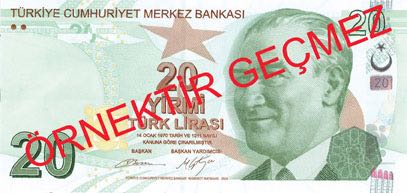
TL 20 (P224): Governor Erdem Başçı and Deputy Governor Murat Çetinkaya.
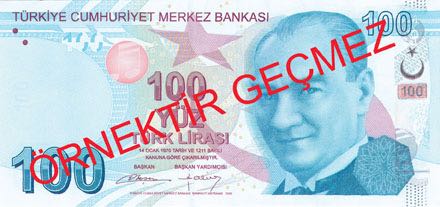
TL 100 (P226): Governor Erdem Başçı and Deputy Governor Necati Şahin.
Courtesy of Okyay Demirors and Hartmut Fraunhoffer.

TL 10 (P223): Governor Erdem Başçı and Deputy Governor Necati Şahin.

TL 20 (P224): Governor Erdem Başçı and Deputy Governor Murat Çetinkaya.

TL 100 (P226): Governor Erdem Başçı and Deputy Governor Necati Şahin.
Courtesy of Okyay Demirors and Hartmut Fraunhoffer.
Banknotes of the Ottoman Empire receives IBNS Book of the Year Award for 2012
13 08, 2012 09:20 Category: Book
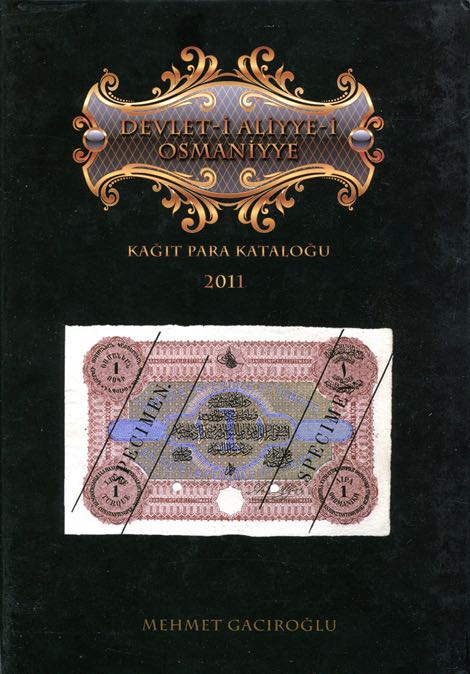
The International Bank Note Society (IBNS) has this year awarded its Book of the Year, for a book published in 2011, to Devlet-I Aliyye-I Osmaniyye (Banknotes of the Ottoman Empire) by Mehmet Gaciroglu. With splendid competition from the ever-increasing works on paper money, the IBNS is pleased to recognize an outstanding accomplishment.
Several reference works on the banknotes of the Ottoman Empire have been written in recent years, but the recently published, award-winning volume by Mehmet Gaciroglu is an impressive contribution to understanding paper money issues in the Ottoman Empire. The distinguished presentation of the book is noteworthy, with its gold title on the dark-coloured cover indicating the quality of the content. Over 340 pages of gloss paper with good quality illustrations, predominantly in colour, continue the impressive presentation.
The merit of the book, however, is in its content. For each denomination identified in the book, descriptions include: the dates of issue, size of the note, the group of issue, signatures, quantity issued, seal used, serial number range and remarks. Where banknotes are illustrated, watermark and signature varieties are adjacent to the banknote; which makes the identification of a banknote very easy for the reader. Values for the notes are given in the grades Fine, VF, XF and UNC, except where the notes are rare and values are sensibly omitted.
A transliteration from Arabic script to modern Turkish script, for both the front and back of the notes, assists readers without the linguistic skills to understand the original text. The Turkish text of the book is complemented with an equal amount of English text, which widens the audience for the book.
Not just a catalogue, the book includes biographies of Sultans and descriptions of the seals used on the notes. Towards the back of the book is a section with colour plates of specimens, essays, artist’s sketches, errors, endorsement stamps and cancellations. Included are the British Gallipoli notes, German legion issues, municipal currencies and local Hebrew, Armenian and Greek issues.
While Banknotes of the Ottoman Empire is deserving of the IBNS Book of the Year, the IBNS gave several Honourable Mentions to other books on paper money published during 2011. These are:
- Billetes de Chile 1879-2011 by Miguel A.Fajardo
- Presidency Banknotes of India (1770-1860) by Kishore Jhunjhunwalla and Rezwan Razack
- New Zealand History Noted – Reserve Bank of New Zealand Bank Notes by Robert Pepping
- Notafilia y Ciencias de la Salud by Jaime Casas PIa (A.N.E.)
- Les Eurobillets – 2002-2011 by Guy Sohier
- English Paper Money – Treasury and Bank of England Notes from 1694 (8th Edition) by Pam West
Turkey issues new notes on 01.01.2009
31 12, 2008 12:06 Category: Europe | South Asia
The name of Turkey’s currency has reverted from “new Turkish lira” (TRY) to “Turkish lira” (TRL) as of 1 January 2009, necessitating the issuance of new banknotes and coins. Turkey last changed the currency by removing six zeroes on 1 January 2005, at a cost of US$300 million. This new move is expected to incur similar costs. Durmuş Yılmaz, governor of the Turkish Central Bank, indicated that a new denomination, the TRL200, would begin circulation as well. The new notes have different sizes as a measure against forgery and to facilitate their use by blind people. The depiction of the country’s founder, Kemal Atatürk, stays on the front of all banknotes; the new designs were unveiled 3 October 2008.
All of the notes have dots in the upper left to assist the visually impaired, microtext, a solid security thread, a holographic stripe, registration device, Omron rings, a latent image, Atatürk as watermark with electrotype denomination, and an iridescent stripe on back. The notes are printed by the Central Bank Banknote Printing House in Ankara.
While each banknote has a portrait of Ataturk, the founder of the modern Republic of Turkey, on one side, there are portraits of other prominent Turks on the other sides of the banknotes as listed below:
5 TL banknote: Prof. Dr. Aydin Sayili
10 TL banknote: Prof. Dr. Cahit Arf
20 TL banknote: Architect Kemaleddin
50 TL banknote: Ms. Fatma Aliye
100 TL banknote: Itri
200 TL banknote: Yunus Emre
Aydin Sayili (1913-1993) was a historian of science who studied under George Sarton at Harvard. His career was aided by chance meeting with Mustafa Kemal Ataturk, whom he impressed enough to receive a state-supported scholarship to attend graduate school at Harvard.
Cahit Arf (1910-1997) was a Turkish mathematician. He is known for the Arf invariant of a quadratic form in characteristic 2 (applied in knot theory and surgery theory) in topology, the Hasse-Arf theorem in ramification theory, and Arf rings.
Architect Kemaleddin (1870-1927) was a prominent Turkish architect. He is a graudate of civil engineering and studied extensively in Germany. He repaired many mosques. He was chosen as a member to the British Royal Architects Institute. He constructed the Bostanci, Bebek, Yesilkoy and Kutlutepe mosques.
Ms. Fatma Aliye (1862-1939) was the first female novelist in Turkish literature and Islamic geography. She was the daughter of last grand Ottoman histrorian Ahmad Cavdat Pasha.
Itri (1630 or 1640-1712) is a well known and important Turkish composer.
Yunus Emre (1238?-1320?) was a Turkish poet and Sufi mystic. He has exercised immense influence on Turkish literature, from his own day until the present.
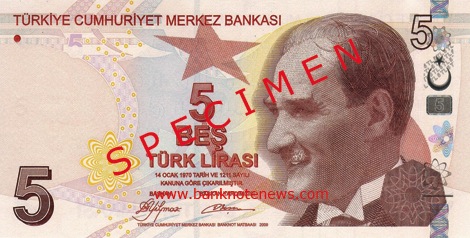
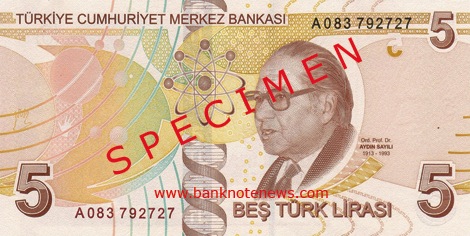
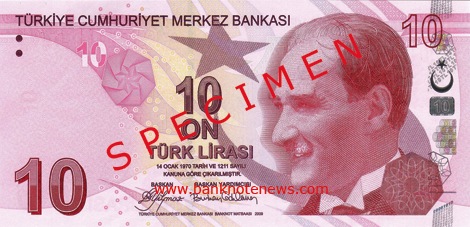


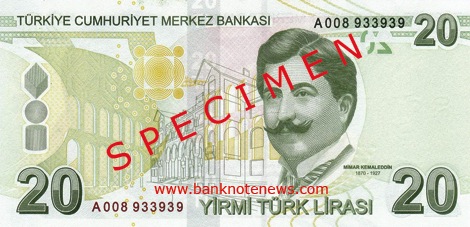
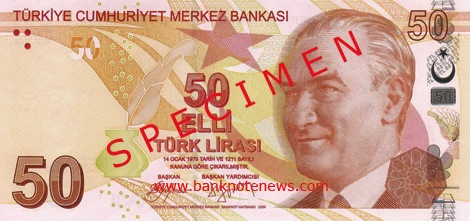
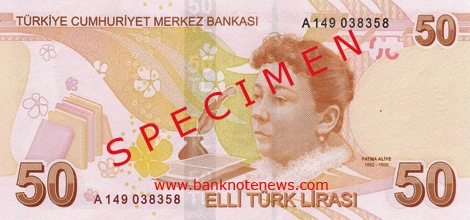
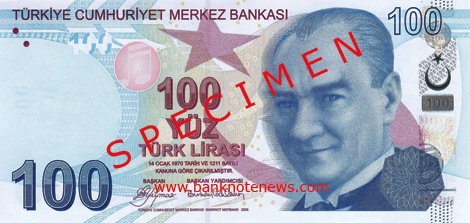
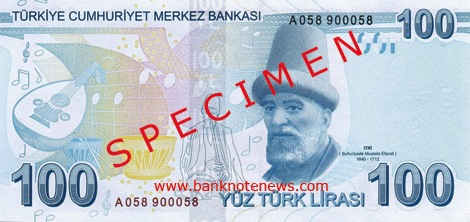
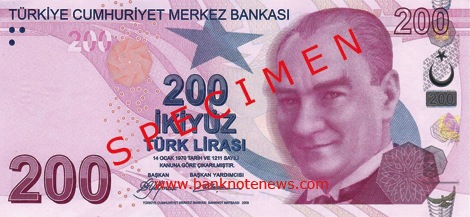
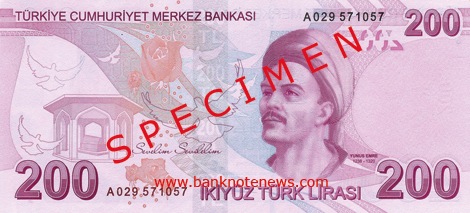
Courtesy of Ömer Yalcinkaya.
All of the notes have dots in the upper left to assist the visually impaired, microtext, a solid security thread, a holographic stripe, registration device, Omron rings, a latent image, Atatürk as watermark with electrotype denomination, and an iridescent stripe on back. The notes are printed by the Central Bank Banknote Printing House in Ankara.
While each banknote has a portrait of Ataturk, the founder of the modern Republic of Turkey, on one side, there are portraits of other prominent Turks on the other sides of the banknotes as listed below:
5 TL banknote: Prof. Dr. Aydin Sayili
10 TL banknote: Prof. Dr. Cahit Arf
20 TL banknote: Architect Kemaleddin
50 TL banknote: Ms. Fatma Aliye
100 TL banknote: Itri
200 TL banknote: Yunus Emre
Aydin Sayili (1913-1993) was a historian of science who studied under George Sarton at Harvard. His career was aided by chance meeting with Mustafa Kemal Ataturk, whom he impressed enough to receive a state-supported scholarship to attend graduate school at Harvard.
Cahit Arf (1910-1997) was a Turkish mathematician. He is known for the Arf invariant of a quadratic form in characteristic 2 (applied in knot theory and surgery theory) in topology, the Hasse-Arf theorem in ramification theory, and Arf rings.
Architect Kemaleddin (1870-1927) was a prominent Turkish architect. He is a graudate of civil engineering and studied extensively in Germany. He repaired many mosques. He was chosen as a member to the British Royal Architects Institute. He constructed the Bostanci, Bebek, Yesilkoy and Kutlutepe mosques.
Ms. Fatma Aliye (1862-1939) was the first female novelist in Turkish literature and Islamic geography. She was the daughter of last grand Ottoman histrorian Ahmad Cavdat Pasha.
Itri (1630 or 1640-1712) is a well known and important Turkish composer.
Yunus Emre (1238?-1320?) was a Turkish poet and Sufi mystic. He has exercised immense influence on Turkish literature, from his own day until the present.












Courtesy of Ömer Yalcinkaya.
